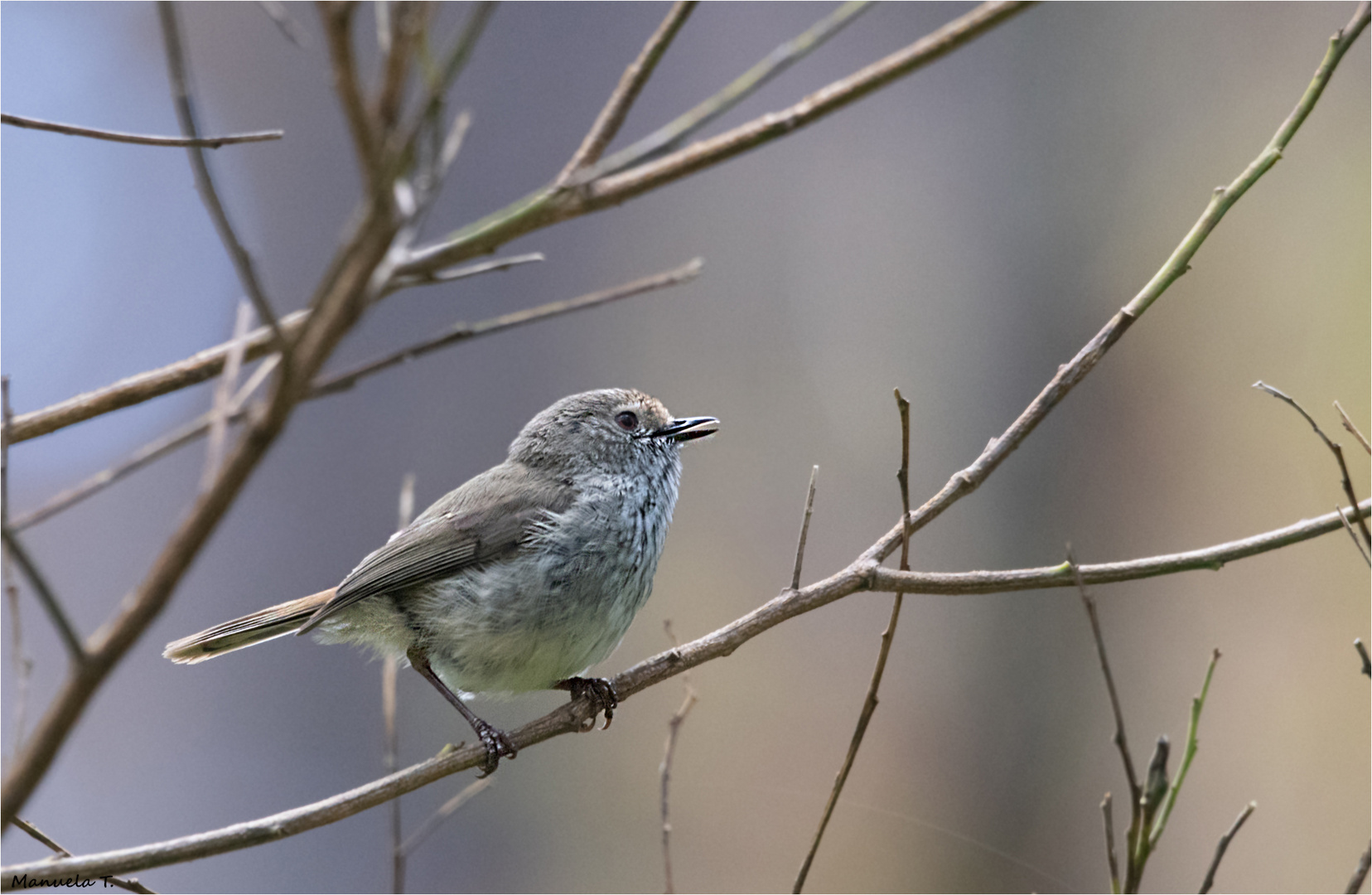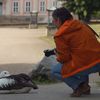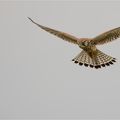Brown Thornbill
Brown Thornbill/ Rotstirn Dornschnabel
Acanthiza pusilla
It was a bit dark there and the little one was hard to catch as he jumped restlessly back and forth
With a size of just ten centimetres, the Brown Thornbill (Acanthiza pusilla) is a real pipsqueak. If its nest and offspring are threatened by a bird of prey, however, it screams like a big one. To distract its predators, the little bird imitates a whole repertoire of alarm calls of other species, which are supposed to announce the attack of an even bigger predator. The strategy of the Brown thornbills is unusual. Although mimicking other species for self-protection is common in the animal kingdom, most animals tend to imitate dangerous species directly to deter their enemies. The tiny Australian birds, however, are probably simply unable to convincingly imitate the sounds of a giant goshawk due to their small size, the scientists suspect. Moreover, hawks are mostly silent hunters that do not warn their prey with attack cries. Therefore, the thornbills resort to a different tactic and protect themselves with the calls of other, equally harmless neighbours. The brown thornbill is found in the eastern and south-eastern parts of Australia , including Tasmania . The Brown Thornbill is mainly an insectivore, including spiders, beetles, lerp insects, ants and grasshoppers in its diet. However, it may sometimes eat seeds, fruits or nectar. It feeds restlessly close to the ground, in lower trees and shrubs of the undergrowth. It often feeds in groups with other thornbirds, except during the breeding season.
Info Spectrum and Wicki
Es war etwas dunkel dort und der Kleine schwer zu erwischen, da er unruhig hin und her sprang
Der Roststirn-Dornschnabel (Acanthiza pusilla) ist mit einer Größe von gerade einmal zehn Zentimetern ein echter Winzling. Werden Nest und Nachwuchs von einem Greifvogel bedroht, dann schreit er allerdings wie ein ganz Großer. Um seine Fressfeinde abzulenken, imitiert der kleine Vogel nämlich gleich ein ganzes Repertoire an Alarmrufen anderer Spezies, die den Angriff eines noch größeren Räubers ankündigen sollen. Die Strategie der Roststirn-Dornschnäbel ist ungewöhnlich. Auch wenn im Tierreich das Nachahmen anderer Arten zum Selbstschutz weit verbreitet ist, so neigen die meisten Tiere doch dazu, gefährliche Spezies direkt zu imitieren, um ihre Feinde abzuschrecken. Die winzigen australischen Vögel sind aber auf Grund ihrer geringen Größe vermutlich schlicht nicht dazu in der Lage, die Laute eines riesigen Habichts überzeugend nachzuahmen, vermuten die Wissenschaftler. Zudem sind Habichte meistens lautlose Jäger, die ihre Beute nicht durch Angriffsschreie warnen. Daher greifen die Dornschnäbel eben auf eine andere Taktik zurück und schützen sich mit den Rufen anderer, ebenso harmloser Nachbarn. Der Braune Dornenvogel kommt in den östlichen und südöstlichen Teilen Australiens , einschließlich Tasmanien , vor . Der Braune Dornvogel ist hauptsächlich ein Insektenfresser , der Spinnen, Käfer, Lerp-Insekten, Ameisen und Heuschrecken in seiner Ernährung umfasst. Es kann jedoch manchmal Samen , Früchte oder Nektar essen . Es ernährt sich unruhig nahe am Boden, in niedrigeren Bäumen und Sträuchern des Unterholzes . Es ernährt sich oft in Gruppen mit anderen Dornvögeln, außer während der Brutzeit .
Infos Spektrum und Wicki
https://ebird.org/species/brotho1
taken 11.22





















Harold Thompson 12/02/2023 16:58
Lovely capture of the little birdHarold and Sue
philipp52 09/02/2023 16:26
in schönem Licht und toller Bildqualität hast du den schönen mir unbekannten Vogel aufg9enommenLG Philipp
Dario Zeller 08/02/2023 20:40
Sehr schön freigestellt. Gefällt mir gut.Cecile 08/02/2023 16:40
Sehr gut die Aufnahme in der Bildschärfe und auch Freistellung.Und eine umfangreiche Info - Danke
Gruß Elfi C.
Maria Lima Marques 08/02/2023 15:42
Sehr schöne Aufnahme von der DomschnabelLgMaria
Gaby Falkenberg 08/02/2023 11:06
Der Kleine ist ja ganz entzückend.Eine wunderschöne Aufnahme in bester Bildqualität.
LG.Gaby
Adele D. Oliver 07/02/2023 21:51
ohhh - he is small and fast, but you did perfectly with this sharpbeautiful portrait ... top and thank you for the interesting info !!
warm regards,
Adele
Axel Sand 07/02/2023 18:17
Das hast Du toll gemacht, Manu. Interessant, was Du berichtest.Gruß Axel
H.D. G. 07/02/2023 17:51
Schade das Du so wenig Licht hattest.Man sieht dem Gefieder die hohe ISO an.
Gruß Dieter
Mark Billiau. 07/02/2023 16:43
Well spotted and beautifully captured in full profile between the branches !Good focus on its eye and thanks for the interesting information.
Vitória Castelo Santos 07/02/2023 16:34
Super gute Aufnahme!LG Vitoria
Tante Mizzi 07/02/2023 15:30
Eine ganz wundervolle Aufnahme von dem hübschen Vogel !!!Ich wünsche Dir einen schönen Tag und bleib gesund!
Liebe Grüße
Mizzi
Blula 07/02/2023 14:38
Bravo, Manu, hier hast Du bestimmt alle Register ziehen müssen, um dieses kleine Vögelchen in solcher Schärfe einzufangen. Das Dämmerlicht hat die Sache noch erschwert. Und gerade dieses Licht macht dieses Foto jetzt so besonders.Ein feines und ausgesprochen farbharmonisches Bild ist das geworden.
LG Ursula
Marina Luise 07/02/2023 13:41
Der sieht schon nach unruhigem 'Fipsi' aus! :))Ein niedlicher kleinen Kerl! :)
Raimo Ketolainen 07/02/2023 11:04
Rauhallinen tausta korostaa kohdetta